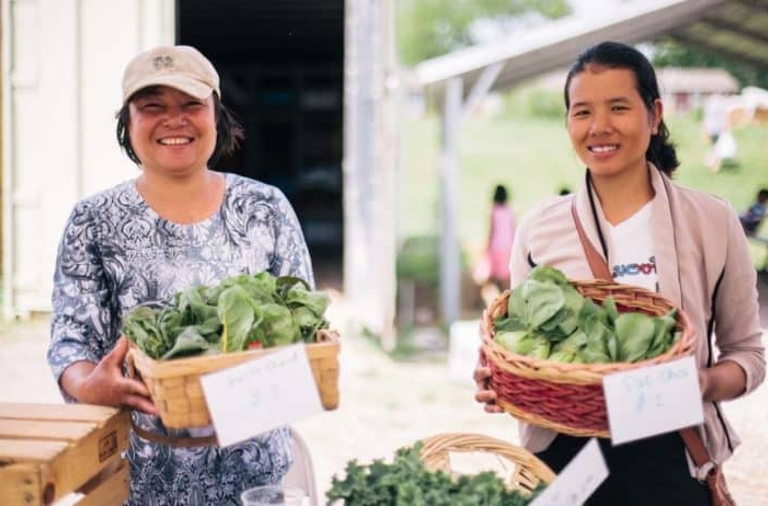On a recent Saturday, the Overland Park, Kansas, Farmers’ Market bustled with customers by 7:30 a.m. Amid dozens of vendors, four graduates from the New Roots for Refugees program sold sustainably grown kale, plump cucumbers, enormous scallions, bright red cherry tomatoes, and more.
It’s been 10 years since Catholic Charities of Northeast Kansas and Cultivate Kansas City launched New Roots for Refugees. When refugees resettle in the Kansas City area, Catholic Charities provides case management and job development services, English classes, and emotional support for refugees, as well as recruits program participants, while Cultivate oversees farm operations.
According to The Washington Post, nationwide, refugees to the U.S. typically become self-sufficient within seven years. New Roots for Refugees participants spend an average of four years learning regionally appropriate farming techniques at Juniper Gardens Training Farm. Home to Cultivate Kansas City’s Farm Business Development Program, Juniper Gardens follows strict organic principles.
The program empowers graduates to eventually acquire their own land so they can continue farming by the end of their four-year training program; expand their businesses; and continue selling produce at markets where they sold during training. With support from the U.S. Department of Agriculture’s National Institute of Food and Agriculture, New Roots has already assisted refugees from Somalia, Myanmar, Burundi, Bhutan, Sudan, and elsewhere. This year, most farmers come from Myanmar.
Spread across eight acres, 15 refugees currently tend multiple varieties of about 20 species on individual plots, each one-fourth of an acre. That translates into 60 to 100 different plant varieties. Although all participants have previous agricultural experience, the program helps them to navigate their new climate and the food preferences of U.S. customers. That may mean growing beets, even though they may not eat beets themselves, while introducing produce that reflects their native cultures, such as water spinach and bok choy.
“During the first year that a farmer participates, Cultivate Kansas City and Catholic Charities help cover costs of everything including seeds, supplies, water, marketing expenses, and farmers’ market fees, with an agreement that they bank 30 percent for sales taxes and cash flow,” says Mary Nguyen, Cultivate Kansas City Communications Manager. There’s plenty of farm equipment available, and farming costs are made more economical by avoiding pesticide use. An expansive washing shed and an 8 by 30-foot (about 2.5 by 9-meter) walk-in cooler facilitate produce prep for sales.
“In the second year, each farmer receives the same fixed amount of Juniper Dollars (a fake currency) at the beginning of the season to spend with Catholic Charities, based on the organizations’ current budget,” Nguyen says. “Through the third year and fourth years, farmers work to cover 100 percent of their costs, excluding land rental.” Subsidies continue towards straw for mulch and fertilizer.
“Some farmers have off-farm jobs and are only able to come to the farm in the evenings after work,” says Kate Johnson, Farm Trainer. “Some work alone, while others make farm work a family affair. Every farmer [attends] at least one farmers’ market per week. Second to fourth-year farmers have community-supported agriculture (CSA) members and nearly all farmers also participate in bulk sales to restaurants each week.”
Farmers learn through workshops, classes, and field walks. “During field walks, I try to provide suggestions for problems that farmers might be having in their fields,” Johnson says. “This season, we have had a lot of pest pressure, so we discuss different strategies for managing the bugs.
“When farmers aren’t finding much success at their farmers markets, we might go into the cooler and discuss how they bunch/display/price their produce. At the start of the season, several farmers were struggling to sell all of [their] produce, so we discussed using succession planting, to decrease the amount of waste and increase the length of the harvest season. “Any questions the farmers have, I try to provide several possible solutions, because in farming, there is never one right answer. If I don’t have good suggestions, I research the topic and help them to sort through the results.”
This season, 14 of the 15 farmers require interpretation to best communicate with English speaking staff. Thankfully, many of their children are strong English speakers who can help facilitate conversations when interpreters are not around. “In my work organizing restaurant orders, I know that if I text a farmer, many times I won’t hear back from them until their kids get home from school or work,” Johnson says.
“The farm also creates community for the farmers. While many of them come from different parts of the world, everyone has a passion for growing food, which becomes the common language on the farm.”





